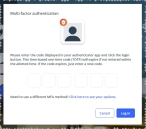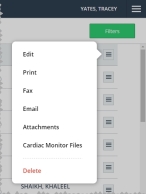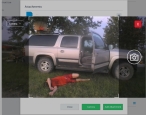Attach and work with files
You can add a wide variety of file attachments to a patient record, such as images, PDF files, Word documents, spreadsheets, and so forth. You can also change the description for attachments, download them, and if necessary, delete them.
-
 (If you have not done so already) Access the EHR module in the ESO Suite.
(If you have not done so already) Access the EHR module in the ESO Suite.
-
Do one of the following.
-
(If you are already working in the ESO Suite) Click the Home icon in the upper left corner of the screen.
-
 (If you have not yet logged in) Log in to the ESO Suite.
(If you have not yet logged in) Log in to the ESO Suite.
-
In a web browser, go to https://www.esosuite.net/EsoSuite.
The ESO Suite login screen appears.
-
Enter your user name, password, and agency name, then click Let's Go.
If MFA is enabled, the Multi-factor authentication dialog box appears, displaying one or more methods you can use to verify your login credentials. The number of methods that appear in the dialog box depends on what MFA methods your ESO Suite administrators enabled in the Admin module.

Click graphics
to open them.Information on enabling MFA and specific MFA methods is available in the Admin module online help, in Configure multiple-factor authentication.
Note: If your ESO Suite administrators have disabled MFA ("opted-out"), this dialog does not appear.
-
(If the Multi-factor authentication dialog box appears) Depending on which buttons appear in the dialog box, verify your login in one of the following ways.
 With an authenticator application.
With an authenticator application.
-
Click MFA verification via authenticator app.
The dialog box updates with boxes for entering the numbers of the authentication code, and the ESO Suite sends an authentication code to the authenticator application installed on your device.
-
Open your authenticator application and note the authentication code currently displayed.
-
Enter the authentication code displayed in the authenticator application.
-
Click Log In.
 With a text message (SMS).
With a text message (SMS).
-
Click MFA verification via SMS.
The dialog box updates with boxes for entering the numbers of the authentication code, and the ESO Suite sends an authentication code to the phone number recorded in your PM records and identified with MFA codes.
-
Enter the authentication code sent to your MFA-registered phone number.
-
Click Log In.
 With an email message.
With an email message.
-
Click MFA verification via email.
The dialog box updates with boxes for entering the numbers of the authentication code, and the ESO Suite sends an authentication code to your agency or department email address, recorded in your PM records.
-
Enter the authentication code sent to your agency or department email address.
-
Click Log In.
-
-
The ESO Suite landing screen appears.

Click graphics
to open them.Note: If MFA is enabled, you can access and manage your MFA options through the PM module, on the Settings > Account page, as described in Manage a user account. If your agency or department has enabled MFA but has not purchased the full-featured version of the PM module, you can access your own MFA settings by clicking Change my Multi-Factor Authentication settings on the landing screen, then using the Settings > Account page that appears. If your agency has not enabled MFA, the Change my Multi-Factor Authentication settings link does not appear on the landing screen.
-
-
On the top side of the home screen, click EHR.
Tip: If your screen or browser window is too narrow to display all your agency's ESO Suite module icons, an options icon appears on the right side of the icon bar. If you click the options icon, a menu appears containing additional module icons.
The EHR screen appears, displaying a list of patient records in the EHR module. The most-recent records appear at the top of the list.
Different record status icons can appear in the list.
Icon Status Unlocked/DraftThe patient record exists in the ESO Suite database, and all crew members listed in the patient record may edit all fields in the record. ESO Suite administrators and personnel with security roles of either
EHR SupervisororEHR Managercan edit non-clinical fields.MobileThe patient record exists on the mobile device, and has not been synchronized with the ESO Suite database. ESO Suite administrators, personnel with security roles of either
EHR SupervisororEHR Manager, and all crew members listed in the patient record can only access a print view of the record.Once the Mobile record synchronizes with the ESO Suite database. the record reflects its current status.
LockedThe patient record exists in the ESO Suite database, and is locked. Only non-clinical fields can be edited by crew members listed in the patient record, ESO Suite administrators and personnel with security roles of either
EHR SupervisororEHR Manager.
-
-
Find the patient record you want to work with.
Information on searching for a record is available in Search for a patient record.
-
Depending on what screen you are on in the EHR module, do one of the following.
If you are here Do this On the list of patient records
In an opened patient record
-
Do one of the following.
-
(For any kind of file attachment) From the menu in the upper right corner of the screen, choose Attachments.
The Attachments dialog box appears.
-
(For a photo attachment) Click the camera icon in the upper right corner of the screen.
The Attachments dialog box appears with a camera view box over it and the current view through the device's built-in camera showing in the center of the dialog box.
-
-
-
Do any of the following.
 (If the camera view box appears over the Attachments dialog box) Take a picture with your mobile device.
(If the camera view box appears over the Attachments dialog box) Take a picture with your mobile device.
-
(If you have more than the device's camera available) On the left side of the dialog box, click Camera, then choose the type of camera to use when taking the picture.
-
On the left side of the dialog box, click the camera icon.
Your device takes the picture with the selected camera, and a picture dialog box appears over the dialog box.
-
 (Optional) Add marks and annotations to the picture.
(Optional) Add marks and annotations to the picture.
-
In the upper right corner of the picture dialog box, click the annotations menu icon.
A menu of color choices and a slider for changing the line thickness appears.
-
Do one of the following:
-
Choose the dot corresponding to the color of the annotation you would like to add.
-
Drag the dot on the slider to the left or right, to decrease or increase the thickness of the annotation you will draw.
The menu automatically closes after you make your color selection or move the slider dot.
Note: If you want to update both the thickness and the color for the annotation, you need to repeat the previous two steps for the other function.
-
-
Place your mouse pointer on the image you captured and drag it as needed to add circles, arrows, and other marks to the image.
-
 If necessary) Remove all annotation marks from the image.
If necessary) Remove all annotation marks from the image.
-
In the upper right corner of the dialog box, click Clear all.
A confirmation dialog box appears.
-
Click Yes.
-
-
In the lower right corner of the dialog box, click Accept.
The Add Attachment dialog box appears, displaying a thumbnail version of the picture you took. In File, the EHR module populates the file name of the picture, based on the incident number and appended with
Photoand a number.
-
-
 (If necessary) Retake the picture of the scene.
(If necessary) Retake the picture of the scene.
-
Click Retake.
The black picture box reappears.
-
Repeat the steps above to capture and (optionally) annotate the new picture.
-
-
In Description, type a short description of the contents of the file you are attaching.
-
Click Attach.
The EHR module attaches the file to the patient record, and a listing of the file appears in the Attachments dialog box.
-
Click Close.
On the EHR screen displaying the list of patient records, a number appears next to the paperclip icon in the patient's listing, to indicate how may files are attached to the patient record.
 Add a new attachment.
Add a new attachment.
You can attach files to the patient record by either choosing an existing file, or by using the mobile device's camera to take a picture in the moment and using the new image as the attachment.
-
Depending on your circumstances, do one of the following.
 Choose an existing file.
Choose an existing file.
-
In the lower left corner of the dialog box, click Add Attachment.
The Add Attachment dialog box appears.
-
For File, click Browse, then navigate to and choose the file you want to attach to the patient's record.
If you selected an image file, a thumbnail version of that file appears in the dialog box.
 Take a picture with your mobile device.
Take a picture with your mobile device.
-
In the lower left corner of the dialog box, click Camera.
A black box appears, with the current view through the device's built-in camera showing in the center of the dialog box.
-
(If you have more than the device's camera available) On the left side of the dialog box, click Camera, then choose the type of camera to use when taking the picture.
-
On the left side of the dialog box, click the camera icon.
Your device takes the picture with the selected camera, and a picture dialog box appears over the dialog box.
-
 (Optional) Add marks and annotations to the picture.
(Optional) Add marks and annotations to the picture.
-
In the upper right corner of the picture dialog box, click the annotations menu icon.
A menu of color choices and a slider for changing the line thickness appears.
-
Do one of the following:
-
Choose the dot corresponding to the color of the annotation you would like to add.
-
Drag the dot on the slider to the left or right, to decrease or increase the thickness of the annotation you will draw.
The menu automatically closes after you make your color selection or move the slider dot.
Note: If you want to update both the thickness and the color for the annotation, you need to repeat the previous two steps for the other function.
-
-
Place your mouse pointer on the image you captured and drag it as needed to add circles, arrows, and other marks to the image.
-
 If necessary) Remove all annotation marks from the image.
If necessary) Remove all annotation marks from the image.
-
In the upper right corner of the dialog box, click Clear all.
A confirmation dialog box appears.
-
Click Yes.
-
-
In the lower right corner of the dialog box, click Accept.
The Add Attachment dialog box appears, displaying a thumbnail version of the picture you took. In File, the EHR module populates the file name of the picture, based on the incident number and appended with
Photoand a number.
-
-
 (If necessary) Retake the picture of the scene.
(If necessary) Retake the picture of the scene.
-
Click Retake.
The black picture box reappears.
-
Repeat the steps above to capture and (optionally) annotate the new picture.
-
-
-
In Description, type a short description of the contents of the file you are attaching.
-
Click Attach.
The EHR module attaches the file to the patient record, and a listing of the file appears in the Attachments dialog box.
-
(If necessary) Repeat steps a–c to add more attachments to the patient record.
-
Click Close.
On the EHR screen displaying the list of patient records, a number appears next to the paperclip icon in the patient's listing, to indicate how may files are attached to the patient record.
-
-
Click Close





















